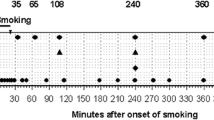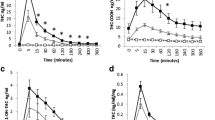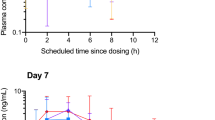Abstract
Rationale
Δ9-Tetrahydrocannabinol (THC) is the main active constituent of cannabis. In recent years, the average THC content of some cannabis cigarettes has increased up to approximately 60 mg per cigarette (20% THC cigarettes). The pharmacokinetics of THC after smoking cannabis cigarettes containing more than approximately 35 mg THC (3.55% THC cigarettes) is unknown. To be able to perform suitable exposure risk analysis, it is important to know if there is a linear relation at higher doses.
Objectives
The present study aimed to characterise the pharmacokinetics of THC, the active metabolite 11-OH-THC and the inactive metabolite THC-COOH after smoking a combination of tobacco and cannabis containing high THC doses.
Materials and methods
This double-blind, placebo-controlled, four-way, cross-over study included 24 male non-daily cannabis users (two to nine joints per month). Participants were randomly assigned to smoke cannabis cigarettes containing 29.3, 49.1 and 69.4 mg THC and a placebo. Serial serum samples collected over a period of 0–8 h were analysed by liquid chromatography electrospray tandem mass spectrometry. Effects on heart rate, blood pressure and ‘high’ feeling were also measured.
Results
Mean maximal concentrations (C max) were 135.1, 202.9 and 231.0 μg/L for THC and 9.2, 16.4 and 15.8 μg/L for 11-OH-THC after smoking a 29.3-, 49.1- and 69.4-mg THC cigarette, respectively. A large inter-individual variability in C max was observed. Heart rate and ‘high’ feeling significantly increased with increasing THC dose.
Conclusions
This study demonstrates that the known linear association between THC dose and THC serum concentration also applies for high THC doses.



Similar content being viewed by others
References
Agurell S, Halldin M, Lindgren JE, Ohlsson A, Widman M, Gillepsie H, Hollister L (1986) Pharmacokinetics and metabolism of delta 1-tetrahydrocannabinol and other cannabinoids with emphasis on man. Pharmacol Rev 38:21–43
Anzenbacher P, Anzenbacherová E (2001) Cytochromes P450 and metabolism of xenobiotics. Cell Mol Life Sci 58:737–747
Barnett G, Chiang CW, Perez-Reyes M, Owens SM (1982) Kinetic study of smoking marijuana. J Pharmacokinet Biopharm 10:495–506
Bornheim LM, Lasker JM, Raucy JL (1992) Human hepatic microsomal metabolism of Δ1-tetrahydrocannabinol. Drug Metab Depos 20:241–246
El Sohly MA (2004) Quarterly report potency monitoring project #85. National Center for Natural Products Research, University of Mississippi, Oxford, USA
EMCDDA (2007) Annual report from the EU drugs agency: the state of the drugs problem in Europe. Available at http://www.emcdda.europa.eu/html.cfm/index419EN.html
Fant RV, Heishman SJ, Bunker EB, Pickworth WB (1998) Acute and residual effects of marijuana in humans. Pharmacol Biochem Behav 60:777–784
Grothenhermen F (2003) Pharmacokinetics and pharmacodynamics of cannabinoids. Clin Pharmacokinet 42:327–360
Gustafson RA, Moolchan ET, Barnes A, Levine B, Huestis MA (2003) Validated method for the simultaneous determination of Delta 9-tetrahydrocannabinol (THC), 11-hydroxy-THC and 11-nor-9-carboxy-THC in human plasma using solid phase extraction and gas chromatography-mass spectrometry with positive chemical ionization. J Chromatogr B Analyt Technol Biomed Life Sci 798:145–154
Hart CL, van Gorp W, Haney M, Foltin RW, Fischman MW (2001) Effects of acute smoked marijuana on complex cognitive performance. Neuropsychopharmacology 25:757–765
Huestis MA, Sampson AH, Holicky BJ, Henningfield JE, Cone EJ (1992a) Characterization of the absorption phase of marijuana smoking. Clin Pharmacol Ther 52:31–41
Huestis MA, Henningfield JE, Cone EJ (1992b) Blood cannabinoids. I. Absorption of THC and formation of 11-OH-THC and THCCOOH during and after smoking marijuana. J Anal Toxicol 16:276–282
Huestis MA, Henningfield JE, Cone EJ (1992c) Blood cannabinoids. II. Models for the prediction of time of marijuana exposure from plasma concentrations of delta 9-tetrahydrocannabinol (THC) and 11-nor-9-carboxy-delta 9-tetrahydrocannabinol (THCCOOH). J Anal Toxicol 16:283–290
Kintz P, Cirimele V (1997) Testing human blood for cannabis by GC-MS. Biomed Chromatogr 11:371–373
Lane SD, Cherek DR, Tcheremssine OV, Lieving LM, Pietras CJ (2005) Acute marijuana effects on human risk taking. Neuropsychopharmacology 30:800–809
Lindgren JE, Ohlsson A, Agurell S, Hollister L, Gillepsie H (1981) Clinical effects and plasma levels of delta 9-tetrahydrocannabinol (delta 9-THC) in heavy and light users of cannabis. Psychopharmacology 74:208–212
Maralikova B, Weinmann W (2004) Simultaneous determination of Delta9-tetrahydrocannabinol, 11-hydroxy-Delta9-tetrahydrocannabinol and 11-nor-9-carboxy-Delta9-tetrahydrocannabinol in human plasma by high-performance liquid chromatography/tandem mass spectrometry. J Mass Spectrom 39:526–531
Moeller MR, Doerr G, Warth S (1992) Simultaneous quantitation of delta-9-tetrahydrocannabinol (THC) and 11-nor-9-carboxy-delta-9-tetrahydrocannabinol (THC-COOH) in serum by GC/MS using deuterated internal standards and its application to a smoking study and forensic cases. J Forensic Sci 37:969–983
Niesink RJM, Rigter S, Hoek J, Goldschmidt H (2007) THC-concentraties in wiet, nederwiet en hasj in Nederlandse coffeeshops (2006–2007). Trimbos Instituut, Utrecht, The Netherlands
Ohlsson A, Lindgren JE, Wahlén A, Agurell S, Hollister LE, Gillepsie HK (1982) Single dose kinetics of deuterium labelled delta 1-tetrahydrocannabinol in heavy and light cannabis users. Biomed Mass Spectrom 9:6–10
Perez-Reyes M, Di Guiseppi S, Davis K, Schindler VH, Cook CE (1982) Comparison of effects of marihuana cigarettes of three different potencies. Clin Pharmacol Ther 31:617–624
Ramaekers JG, Kauert G, van Ruitenbeek P, Theunissen EL, Schneider E, Moeller MR (2006) High-potency marijuana impairs executive function and inhibitory motor control. Neuropsychopharmacology 31:2296–2303
Tanswell P, Koup J (1993) TopFit: a PC-based pharmacokinetic-pharmacodynamic data analysis program. Int J Clin Pharm Ther Toxicol 31:514–520
Thomas BF, Compton DR, Martin BR (1990) Characteristization of the lipophility of natural and synthetic analogs of delta 9-tetrahydrocannabinol and its relationship to pharmacological potency. J Anal Toxicol 255:624–630
Valjent E, Mitchell JM, Besson MJ, Caboche J, Maldonado R (2002) Behavioural and biochemical evidence for interactions between Delta 9-tetrahydrocannabinol and nicotine. Br J Pharmacol 135:564–578
Watanabe K, Yamaori S, Funahashi T, Kimura T, Yamamoto I (2007) Cytochrome P450 enzymes involved in the metabolism of tetrahydrocannabinols and cannabinol by human hepatic microsomes. Life Sci 80:1415–1419
Widman M, Agurell S, Ehrnebo M, Jones G (1974) Binding of (+)- and (−)-D1-tetracannabinols and (−)-7-hydroxy-Δ1-tetracannabinol to blood cells and plasma proteins in man. J Pharm Pharmacol 26:914–916
World Drug Report (2006) Volume 1 (analysis). United Nations Office on Drugs and Crime, United Nations Publication Sales No. E.06.XI.10
Acknowledgments
This study was funded by the Ministry of Health, Welfare, and Sport of the Netherlands, which had no further role in study design, data collection, analysis and interpretation of data and writing the reports. The authors declare that the study complies with the current Dutch laws, i.e. the country in which the study was performed.
Author information
Authors and Affiliations
Corresponding author
Additional information
Trial registration: ClinicalTrials.gov identifier, NCT00225407
Appendix
Appendix
Serum was cleaned by solid phase extraction on a Focus SPE cartridge (3 ml, 20 mg; Varian, USA) using 1.0-ml samples. Concentrations of THC and its metabolites 11-OH-Δ9-THC (11-OH-THC) and 11-nor-carboxy-Δ9-THC (THC-COOH) were determined with liquid chromatography electrospray tandem mass spectrometry (LC-ESI±MS/MS), using a Finnigan surveyor with quantum discovery mass spectrometer (Thermo Electron, USA). Chromatographic separation (20 μl injection volume) was achieved in 10 min over a Polaris C18-A (100 × 2.0 mm) 5 μ column (Varian, USA) using gradient elution with an aqueous mobile phase (containing 0.01% trifluoracetic acid and a organic phase using methanol and acetonitrile), at a flow rate of 0.4 mL/min. Standards for the drugs were obtained from Cerilliant, Texas, USA and diluted in drug-free human plasma at a concentration ranging between 0 and 50.0 μg/L. D3-deuterated standards for THC and THC-COOH were purchased from the same corporation and added as an internal standard at the concentration of 50 μg/L. The mass spectrometer was operated in electrospray ionisation positive ion mode, and quantitation was conducted using selected reaction monitoring. Calibration analyses were completed according to internal standard methods with the Xcalibur software (Thermo Electron) using calibration curves with linear fit identification. The LOQ for THC, 11-OH-THC and THC-COOH were 0.5, 0.5 and 1.0 μg/L, respectively.
Rights and permissions
About this article
Cite this article
Hunault, C.C., Mensinga, T.T., de Vries, I. et al. Delta-9-tetrahydrocannabinol (THC) serum concentrations and pharmacological effects in males after smoking a combination of tobacco and cannabis containing up to 69 mg THC. Psychopharmacology 201, 171–181 (2008). https://doi.org/10.1007/s00213-008-1260-2
Received:
Accepted:
Published:
Issue Date:
DOI: https://doi.org/10.1007/s00213-008-1260-2




